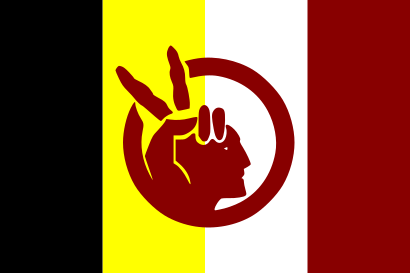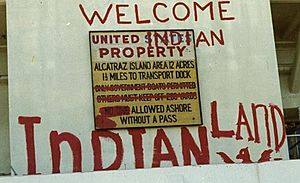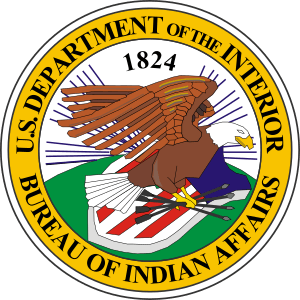Red Power movement facts for kids
Quick facts for kids Red Power movement |
|||
|---|---|---|---|
| Part of Civil rights movements | |||

Flag of the American Indian Movement
|
|||
| Date | 1960s – 1970s | ||
| Location |
Mainly the United States, also Canada
|
||
| Caused by | Oppression of American Indians | ||
| Goals | Recognition by US, American Indian awareness | ||
| Methods | Occupations, Armed Struggle, Protest | ||
| Parties to the civil conflict | |||
|
|||
| Lead figures | |||
|
|
|||
The Red Power movement was an important social movement in the United States. It was led by young Native American people. They wanted Native Americans to have more control over their own lives, lands, and resources. They also wanted the US government to recognize their rights.
Key groups in this movement included the American Indian Movement (AIM) and the National Indian Youth Council (NIYC). Unlike older groups that used talks and agreements, Red Power groups often used protests and peaceful disobedience to make changes. The movement helped bring back pride and awareness for Native Americans across the country.
The phrase "Red Power" was first used by author Vine Deloria, Jr.. It showed a growing sense of shared identity among Native Americans in the late 1960s.
Some major events of the movement were the Occupation of Alcatraz, the Trail of Broken Treaties, and the Occupation of Wounded Knee. The movement led to many new laws that helped Native Americans. One big success was stopping the government from ending its official recognition of Native American tribes.
Why the Movement Started
From 1953 to 1964, the United States government stopped recognizing more than 100 Native American tribes as independent nations. This meant these tribes lost their right to govern themselves. They were no longer protected by the government in the same way.
The Indian Relocation Act of 1956 also encouraged many Native Americans to move from their reservations to cities. The government promised jobs, housing, and training. However, these promises were often not kept. Many Native Americans ended up worse off and far from their cultural homes.
These government actions made Native Americans want to fight for their rights. The National Congress of American Indians (NCAI), formed in 1944, was an early group that fought against unfair voting rules and government interference in tribal matters. NCAI helped set the stage for the Red Power movement.
Main Groups Involved
American Indian Movement
The American Indian Movement (AIM) was a leading group in the Red Power movement. It started in 1968 in Minneapolis, Minnesota. AIM members were mostly young, strong leaders from Native American communities in cities.
Like other civil rights groups of the time, AIM first worked to protect Native Americans from police unfairness. They helped create centers and organizations for Native Americans in cities. AIM was good at getting attention from the news. This helped spread news about protests and Native American political issues across the country.
National Indian Youth Council
The National Indian Youth Council (NIYC) was formed in 1961. Its members were young Native American college students or recent graduates. They were one of the first groups to take a more active stand for Native American rights, different from older, more traditional groups.
NIYC strongly disagreed with the Bureau of Indian Affairs (BIA). They were involved in many Red Power events. Like AIM, NIYC believed in and fought for the government to recognize tribes and for tribes to govern themselves again.
Women of All Red Nations
Women of All Red Nations (WARN) started in 1974. It was founded by Lorelei DeCora Means, Madonna Thunderhawk, Phyllis Young, Janet McCloud, and others. WARN was a part of AIM that focused on the rights of Native American women and families.
WARN fought against medical procedures done on Native women without their permission. They also worked to improve health services on reservations. WARN helped in custody battles for Native children. They protested companies that were polluting Native food and water sources.
International Indian Treaty Council
The International Indian Treaty Council (IITC) was created in 1974 in Standing Rock, South Dakota. More than 98 Indigenous tribes and over 5,000 people attended its first meeting. IITC became a voice for Indigenous peoples around the world.
IITC works to help Indigenous peoples gain control over their own lives and lands. They do this through activism, training, and meetings. In 1977, IITC became the first Indigenous group to work with the United Nations. This allowed them to speak up for Indigenous rights on a global stage.
Key Events
From 1969 to 1978, the Red Power movement used protests to highlight important issues. They wanted the government to honor old treaties. They also wanted more money for education, housing, and healthcare to help Native Americans living in poverty. The movement helped create Native American colleges and study programs at other universities. It also led to the creation of museums and cultural centers to celebrate Native American contributions.
The 1960s also saw a "Native American Renaissance" in literature. New books like Vine Deloria, Jr.'s Custer Died for Your Sins (1969) became very popular. Many Native American writers, historians, and essayists gained recognition. Authors like N. Scott Momaday, Leslie Silko, Louise Erdrich, Michael Dorris, and Sherman Alexie have continued to share Native American stories with a wide audience.
Occupation of Alcatraz
The Occupation of Alcatraz began on November 20, 1969. More than 80 young Native Americans, mostly college students, went to and took over Alcatraz Island. They called themselves Indians of All Tribes (IAT).
They used an old Sioux Treaty to support their claim. This treaty said that any unused federal land could be claimed by Native Americans. The Alcatraz federal prison had closed in 1962, so the island was no longer in use. The occupiers wanted to show that old treaties were still important and should be respected.
The occupation was planned by Adam Nordwall and Richard Oakes. They told the media about their plan. The IAT group released a statement called the Alcatraz Proclamation. It explained their right to the island. It also compared the empty prison island to the poor conditions on many Native American reservations.
The National Indian Youth Council (NIYC) joined the Alcatraz movement. Richard Oakes became the public face of the occupation. He spoke to the press about their goals, which included building cultural centers and schools for Native Americans on the island.
The occupation ended after several problems. Richard Oakes and his wife left after their 13-year-old stepdaughter died in an accident on the island. Other students went back to school. Electricity and water were cut off. A fire also damaged buildings. On June 11, 1971, police officers removed the last few protesters.
Even though they didn't achieve all their specific goals, the Alcatraz occupation was very important. It helped bring Native American communities together. One participant said, "we got back our worth, our pride, our dignity, our humanity."
Occupation of D-Q University
Young, college-aged students were central to many Red Power protests. Getting higher education, especially for Native Americans, became a key goal. In 1970, while Alcatraz was still occupied, a group of Native American youth took over unused US military land near Davis, California.
These youth had applied for the land, but it was given to UC Davis instead, even though UC Davis's application was not complete. In response, the youth climbed the fences and took over the property. This led to the creation and occupation of D-Q University.
D-Q University became the first tribal university in California. It was also the first not tied to a single reservation. The students were granted ownership of the land in April 1971. D-Q University became part of the Tribal Colleges and Universities system. It offered cultural and traditional education to teach Native Americans about their own heritage.
The university faced challenges with student numbers and funding. It lost its official recognition in 2005. However, the occupation that created D-Q University showed how important higher education was for Native Americans during the Red Power movement.
Trail of Broken Treaties
In August 1972, the Red Power movement continued with the Trail of Broken Treaties. This event was led by the American Indian Movement (AIM). The name was a nod to the "Trail of Tears," a sad time in history when Native Americans were forced from their lands.
Seven groups of Native Americans traveled from the West Coast to the Bureau of Indian Affairs (BIA) in Washington D.C. The BIA was seen by many as corrupt and not working in the best interest of Native Americans. The protesters arrived in D.C. on November 1. They planned to give the BIA a list of twenty demands.
When they arrived, there was a misunderstanding about where the activists would stay. This led to the activists taking over the BIA building on November 2, 1972. They blocked the doors with furniture. This occupation happened just before the presidential election, so it got a lot of media attention.
Police threatened to remove the Native Americans daily. Supporters outside the building formed a human chain to keep police from entering. On November 6, a judge ordered the occupiers to leave. However, the deadline was pushed back to November 8. Before that date, Native American lawyers found evidence of corruption within the BIA.
On November 8, the protesters left the BIA building. They took some paintings and artifacts. The building had about $2 million worth of damage.
Wounded Knee Occupation
The Wounded Knee Incident began on February 27, 1973, and lasted 71 days. More than 200 Native Americans supported the Oglala Sioux people of Pine Ridge Reservation. They took over the town of Wounded Knee, South Dakota.
The Oglala Sioux Civil Rights Organization (OSCRO) was a group of mostly Native American women from Pine Ridge. They were unhappy that their tribal chairman, Dick Wilson, had not been removed from office. They felt he was too close to the government and did not respect Oglala Sioux culture. OSCRO asked AIM for help. They decided to occupy Wounded Knee.
Wounded Knee was chosen to honor the Wounded Knee Massacre of 1890. In that event, hundreds of Lakota Native Americans were killed by US soldiers. The town also had visitor shops that sold Native American crafts. Many Native Americans felt these shops were disrespectful and used their history for money. The occupiers first attacked these shops to get weapons and supplies.
The occupation sent a message: Native Americans would not quietly accept broken treaties, unfair trials, or the loss of their land. Federal agents surrounded Wounded Knee. The occupiers held events for the media to share their message. There were often shootouts at night between the protesters and federal agents. Two Native Americans were killed, and one federal agent was seriously injured.
The death of the second Native American, Buddy Lamont, led many to want the occupation to end. On May 8, 1973, the Native Americans surrendered after 10 weeks. Russell Means, a leader of AIM, negotiated with US forces. He asked for Senate hearings on broken Indian treaties and investigations into the BIA.
This event was important because it showed Native Americans taking strong action. It also inspired many Native Americans to get involved in civil rights and tribal affairs for generations to come. The charges against AIM leaders Russell Means and Dennis Banks were later dropped because the government had unfairly influenced witnesses.
Other Occupations by Red Power Activists
Here is a list of other places occupied by Red Power activists:
- Occupation of Alcatraz - San Francisco, CA (1969)
- Occupations of Argonne National Laboratory, Wrigley Field, and Belmont Harbor Nike site - Chicago, IL (early 1970s)
- Occupation of Winter Dam - Winter, WI (1971)
- Occupation of abandoned Nike Missile Field - Richmond, CA (1971)
- Occupation of abandoned Coast Guard station - Milwaukee, WI (1971)
- Occupation of Alexian Brothers' Novitiate - Gresham, WI (1975)
- Occupation of BIA - Washington, D.C. (1972)
- Occupation of Wounded Knee - Wounded Knee, SD (1973)
Legacy of the Movement
The Red Power movement achieved many of its goals by the late 1970s. By the early 1980s, over 100,000 Native American studies programs had been created in the United States. Many tribal museums also opened. A famous cultural center is the National Museum of the American Indian (NMAI). It opened in Washington, D.C., in 2004.
Many laws were passed because of the Red Power movement. One of the most important was the Indian Self-Determination and Education Assistance Act of 1975. This law reversed the government's policy of ending recognition for tribes. It gave tribes back their right to govern themselves and their reservations. This was a huge success for the movement.
Laws Passed for Native Americans
Here are some laws passed during the Red Power movement:
- Indian Education Act of 1972: This law gave more money to schools with many Native American children.
- Indian Health Service budget: The money for Native American hospitals and clinics doubled from 1970 to 1975.
- Northwest Indian Fisheries Commission (NWIFC): Created in 1975, this group includes members from 20 tribes. They work with the State of Washington to manage natural resources like fish.
- Indian Health Care Improvement Act of 1976: This law improved healthcare for Native Americans. It included scholarships for Native Americans studying medicine and other health fields.
- American Indian Religious Freedom Act of 1978: This law made it legal again for Native Americans to practice their traditional religions, like the sun dance and using sweat lodges.
- Branch of Acknowledgement and Research (BAR): Created by the BIA in 1978, this group processes applications from tribes seeking federal recognition.
- Indian Child Welfare Act of 1978: This law gave tribes some control over the adoption and placement of Native American children. It was a response to the past practice of placing Native children in boarding schools away from their families.
- Tribally Controlled Community College Assistance Act of 1978: This law allowed community colleges to be built on reservations.



